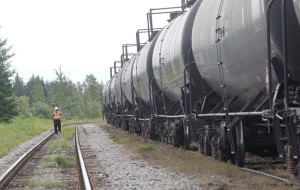Image source: calgaryherald.com
Clyde Sharpe
President for International Sales of Elasto Proxy
What is the role of rubber in transporting crude oil across North America? Last week, we examined how elastomeric seals support pipeline safety. From risers to wellheads to pumps and valves, the oil and gas industry needs reliable rubber products that meet application requirements for temperature, pressure, and oilfield media. As the U.S.-based Plantation Pipe Line company learned in 2006, gasket failure can release fuel into waterways and result in steep fines and environmental damage.
Closer to home and more recently, Canadians are still coping with the disaster at Lac-Mégantic, Québec, the site of a massive train derailment that burned or spilled 5,630,000 liters of light crude oil last July. Owned and operated by the Montreal, Maine, and Atlantic (MMA) Railway, the freight train included 72 tanker cars traveling from North Dakota to New Brunswick. As rail shipments of crude continue to rise, is there anything that can be done to make oil tankers safer?
Rail Safety and Professional Networking
The summer before the Lac-Mégantic disaster, members of the Frac Sand group on LinkedIn may have discovered a solution. In a discussion about open railcars, the head of a transportation company asked for advice about transporting frac sand, a crush-resistant sand that’s used in hydraulic fracturing. As the conversation considered various technologies, a railway executive suggested using rubber bladders and referred to an article about them in World Coal magazine.
As John Licht, the Director of Business Development at Badger Farm Rail explained, rubber bladders are manufactured to military specifications and designed to withstand high temperatures while transporting diesel fuel. Frac sand has different chemical properties than diesel, of course, but could fuel bladders used in military operations withstand railroad conditions? And could rubber bladders serve as secondary containment systems within steel rail cars that carry crude oil?
Crashworthy and Self-Sealing Bladders
The defense industry may hold yet another lesson for railways that haul flammable fuels. As the military contractor Musthane explains, crashworthy and self-sealing bladders are used on-board ships, aircraft, helicopters, and armored vehicles. Made of specialty fabrics coated with urethane or nitrile, these fuel bladders often include aramids along with a special foam that helps to balance the liquid in the tank and avoid explosions.
Aerotec Laboratories (ATL) also manufactures crashworthy fuel tanks for military and civilian customers, including NASCAR and Formula One. Recently, the New Jersey-based company also entered the market for unmanned aerial vehicles (UAVs), supplying lightweight fuel bladders made of rubberized fabrics. To produce leak-tight joints, the seams are vulcanized. Fuel bladder configurations include rectangular and cylindrical, as well as radiused edge and convoluted fuselage.
What’s the Answer?
For Canada’s energy future, the stakes are high – especially in the tragic aftermath of the Lac-Mégantic disaster. Although some may claim that railroads can never be made safe enough, shipments of crude oil are rising – 28,000% in the last 5 years. Could crashworthy rubber bladders in railcars help to avert spills and explosions in the event of another train derailment? What are some other solutions to increase rail safety and avoid another tragedy?
As a supplier of high-quality, custom-fabricated sealing solutions to a variety of industries, Elasto Proxy welcomes this debate and encourages you participate. I hope you’ll comment on this blog entry and share your own knowledge, whether it’s about railcars, petroleum products, or rubber. As the members of the Frac Sand group on LinkedIn can attest, it’s better to work together.











